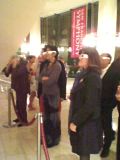 Eliot Spitzer's appearance in Inside Job amused me so much that I knew I would enjoy Client 9, Alex Gibney's documentary about the Spitzer prostitution scandal. The movie is a series of entertaining interviews, beginning with a wacky New York artist in a distracting hat who turns out to be a high-end pimp. Cecil Suwal, partner in the Emperors Club, actually giggles as she explains the pricing scheme for the escorts. Political consultant Roger Stone is engagingly creepy, & former New York Stock Exchange director Kenneth Langone comes across as charming yet dangerous. A woman called "Angelina" is claimed to be Mr. Spitzer's favorite escort. She declined to appear on camera, but her interview is performed primly by actress Wrenn Schmidt. At the end of the film, we are told that Angelina is now a commodities trader. The movie does not completely make its case that Spitzer's downfall was instigated by his enemies on Wall St. & in the Republican party. When discussing the revelations that brought him down, Mr. Spitzer himself displays no traces of personal insight or introspection.
Eliot Spitzer's appearance in Inside Job amused me so much that I knew I would enjoy Client 9, Alex Gibney's documentary about the Spitzer prostitution scandal. The movie is a series of entertaining interviews, beginning with a wacky New York artist in a distracting hat who turns out to be a high-end pimp. Cecil Suwal, partner in the Emperors Club, actually giggles as she explains the pricing scheme for the escorts. Political consultant Roger Stone is engagingly creepy, & former New York Stock Exchange director Kenneth Langone comes across as charming yet dangerous. A woman called "Angelina" is claimed to be Mr. Spitzer's favorite escort. She declined to appear on camera, but her interview is performed primly by actress Wrenn Schmidt. At the end of the film, we are told that Angelina is now a commodities trader. The movie does not completely make its case that Spitzer's downfall was instigated by his enemies on Wall St. & in the Republican party. When discussing the revelations that brought him down, Mr. Spitzer himself displays no traces of personal insight or introspection.I saw Client 9 yesterday afternoon at a matinee in one of the small screening rooms at the Opera Plaza Cinema. The mostly older audience was duly shocked when a nude photo of former escort Ashley Dupre appeared on the screen.
§ CLIENT 9: The Rise and Fall of Eliot Spitzer
Director: Alex Gibney


















